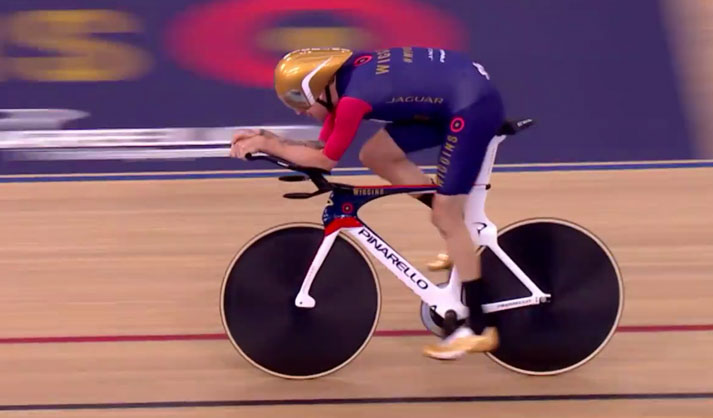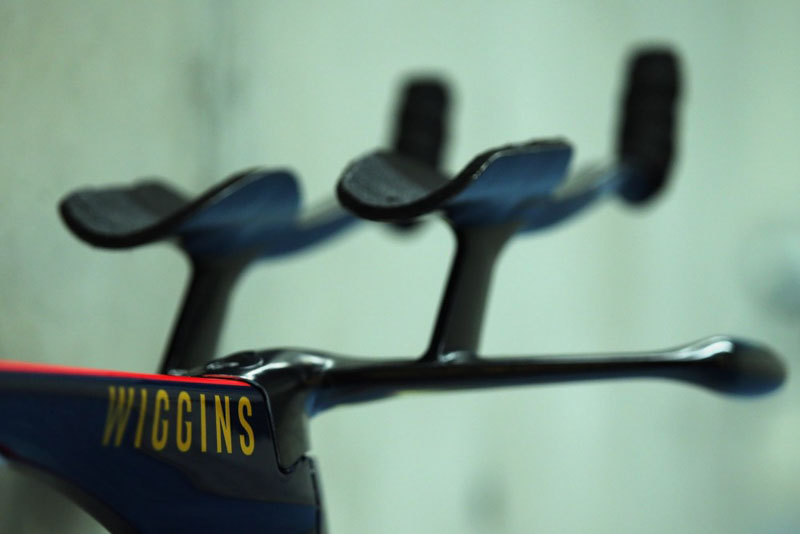Clik here to view.

Wiggins’ Pinarello Hour Record bike. Screenshot image via cyclingtips.com.au
I wrote a bit about my confusion with the UCI after Jens Voight set a new athlete’s (or unified, or whatever we are calling it now) hour record in September of last year. After watching Bradley Wiggins ride an impressive new distance Sunday, I am excited to see that interest in the hour record is back… but I still feel the need to rant a bit.
I have complained about the UCI’s post Lugano Charter equipment restrictions a few times before, so I won’t repeat myself. I will say that I’m glad they changed the rule last year to allow the use of a modern pursuit bike with disc wheels and aerobars for the hour record. It is great that the long overdue revised rule has renewed interest in the Hour, but I really do wish they would relax the rules further to spur innovation in bicycle design. I understand that the UCI wants to outlaw drastically different rider positions, like the “praying mantis” and “superman” positions used by Obree and Boardman to set hour records in the 90s. If they were to allow any rider position at all, a recumbent would be the hour record bike of choice and the distance would be significantly further than Boardman’s 1996 “best human effort” of 56.375 km. It is fine if they want to set rules for rider position and wheel size to maintain the use of an upright track bike, but why can’t they just drop their frame and fork stickering program, set measurement based rules, and allow the use of monocoque frame designs? Seriously, why do these expensive carbon fiber bikes need to follow a 19th century diamond frame design that is based on welded tube construction?
Don’t get me wrong. The custom Jaguar/Pinarello Bolide that Wiggins rode 54.526 kilometers Sunday in London’s Lee Valley Velodrome is certainly impressive from an engineering standpoint (read more about the bike here and here). Imagine what the designers and engineers could have done without the constraint of an open front and rear triangle though. Without the diamond frame shape rule, perhaps Wiggo’s entire bike could have been as innovative as the 3D printed handlebars that are being questioned today by Dowsett’s coach.
Image may be NSFW.
Clik here to view.
As much as I loved seeing the bike that Jaguar, Pinarello, Sky, British Cycling, SRAM and others spent so much time and money to develop for Wiggins’ hour record attempt, it just didn’t generate the same excitement as all of those pre-Lugano Charter (1996) hour record bikes that were truly pushing the limits of frame design. Just compare Wiggins’ Pinarello (or any of the other 2014/15 hour record bikes) to Mike Burrows’ Lotus 108 for Boardman, Obree’s Old Faithful, Moser’s Funny bike, or even Indurain’s Pinarello. With the technological advances of the past 20 years, imagine what the engineers and designers at Jaguar and Pinarello could have created if they weren’t stuck making a high-tech carbon fiber replica of the frame that Henri Desgrange used to set the first official hour record in 1893.
I have called for relaxing the equipment rules many times, and I am not the only one who feels that way. In an excellent post titled “Bikes are Boring”, the folks at Eleven Velo point out that “ever since 1996, every company out there that has any interest in putting bikes in the realm of big time racing has had to suck up the double triangle and move forward with it, regardless of how right or wrong it is. And this is where the folly lies. In a world of carbon, now so prevalent that it’s almost ubiquitous, vast sums of money are being spent to engineer frames from carbon that mimic a structure optimized for round metal tubes.”
Ridiculous, right? The UCI has the power to change the way most sport oriented bikes are designed and developed though. All they need to do to allow innovators in the industry to pick back up where they left off in 1996 is make a simple rule change. How difficult is that?
Clik here to view.

Pre-Lugano Charter hour record bikes (clockwise from top right: Moser, Obree, Indurain, Boardman)
Subscribe to the email newsletter… and follow Bicycle Design on Facebook , Twitter , Pinterest , and Google + .
